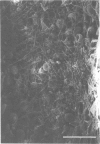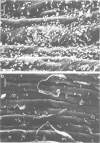Abstract
1. A thrombus was induced in the rat femoral artery by endothelial damage due to the photochemical reaction between systemically-injected Rose Bengal and transillumination with green light (wavelength: 540 nm). The artery of the control rat was completely occluded in 302.8 +/- 27.0 s after the initiation of the reaction. 2. Pretreatment with vapiprost (0.1, 0.3 and 1.0 mg kg-1, i.v., 5 min before the reaction) prolonged the time required to occlude the femoral artery in a dose-dependent manner. The efficacy of vapiprost on the time required for occlusion was over 10 times higher than that of aspirin which was administered 30 min before the reaction. 3. The thrombolytic effects of tissue-type plasminogen activator (tPA) on the established arterial thrombus in the presence and absence of vapiprost were also studied in the same model. When vapiprost (0.3 mg kg-1, i.v.) was administered just before tPA infusion (100 micrograms kg-1 min-1 for 30 min), the time required to reperfuse the occluded artery was reduced, the incidence of the reperfusion was increased and the arterial blood flow after reperfusion was improved. 4. When vapiprost (1.0 mg kg-1 daily p.o.) was administered for 1 week after the establishment of reperfusion by tPA combined with vapiprost, the patency of the reperfused artery was improved and the femoral arterial blood flow was better preserved than after treatment with only tPA. 5. These findings suggest that this thromboxane receptor antagonist may be a useful adjunct to anti-thrombotic therapy. The combination therapy with tPA may be more effective than treatment with tPA alone and provides greater protection against reocclusion after reperfusion.
Full text
PDF





Images in this article
Selected References
These references are in PubMed. This may not be the complete list of references from this article.
- Aiken J. W., Shebuski R. J., Gorman R. R. Blockage of partially obstructed coronary arteries with platelet thrombi: comparison between its prevention with cyclooxygenase inhibitors versus prostacyclin. Adv Prostaglandin Thromboxane Res. 1980;7:635–639. [PubMed] [Google Scholar]
- Ambler J., Birch J., Maguire E. D., Wallis R. B. Role of thromboxane A2. Adv Exp Med Biol. 1985;192:293–308. doi: 10.1007/978-1-4615-9442-0_21. [DOI] [PubMed] [Google Scholar]
- Ashton J. H., Schmitz J. M., Campbell W. B., Ogletree M. L., Raheja S., Taylor A. L., Fitzgerald C., Buja L. M., Willerson J. T. Inhibition of cyclic flow variations in stenosed canine coronary arteries by thromboxane A2/prostaglandin H2 receptor antagonists. Circ Res. 1986 Nov;59(5):568–578. doi: 10.1161/01.res.59.5.568. [DOI] [PubMed] [Google Scholar]
- Best L. C., Holland T. K., Jones P. B., Russell R. G. The interrelationship between thromboxane biosynthesis, aggregation and 5-hydroxytryptamine secretion in human platelets in vitro. Thromb Haemost. 1980 Feb 29;43(1):38–40. [PubMed] [Google Scholar]
- Brezinski M. E., Osborne J. A., Yanagisawa A., Lefer A. M. Beneficial actions of the thromboxane receptor antagonist, AH-23,848, in acute myocardial ischemia. Methods Find Exp Clin Pharmacol. 1987 Nov;9(11):703–709. [PubMed] [Google Scholar]
- Collen D., Topol E. J., Tiefenbrunn A. J., Gold H. K., Weisfeldt M. L., Sobel B. E., Leinbach R. C., Brinker J. A., Ludbrook P. A., Yasuda I. Coronary thrombolysis with recombinant human tissue-type plasminogen activator: a prospective, randomized, placebo-controlled trial. Circulation. 1984 Dec;70(6):1012–1017. doi: 10.1161/01.cir.70.6.1012. [DOI] [PubMed] [Google Scholar]
- Fitzgerald D. J., Fitzgerald G. A. Role of thrombin and thromboxane A2 in reocclusion following coronary thrombolysis with tissue-type plasminogen activator. Proc Natl Acad Sci U S A. 1989 Oct;86(19):7585–7589. doi: 10.1073/pnas.86.19.7585. [DOI] [PMC free article] [PubMed] [Google Scholar]
- Folts J. D., Rowe G. G. Epinephrine potentiation of in vivo stimuli reverses aspirin inhibition of platelet thrombus formation in stenosed canine coronary arteries. Thromb Res. 1988 May 15;50(4):507–516. doi: 10.1016/0049-3848(88)90199-5. [DOI] [PubMed] [Google Scholar]
- Friedman M., Van den Bovenkamp G. J. The pathogenesis of a coronary thrombus. Am J Pathol. 1966 Jan;48(1):19–44. [PMC free article] [PubMed] [Google Scholar]
- Fujita T., Hasan S., Storer B. L., Shebuski R. J. Effect of selective endoperoxide/thromboxane A2 receptor antagonism with sulotroban on tPA-induced thrombolysis in a rabbit model of femoral arterial thrombosis. Fundam Clin Pharmacol. 1989;3(6):643–653. doi: 10.1111/j.1472-8206.1989.tb00465.x. [DOI] [PubMed] [Google Scholar]
- Gold H. K., Leinbach R. C., Garabedian H. D., Yasuda T., Johns J. A., Grossbard E. B., Palacios I., Collen D. Acute coronary reocclusion after thrombolysis with recombinant human tissue-type plasminogen activator: prevention by a maintenance infusion. Circulation. 1986 Feb;73(2):347–352. doi: 10.1161/01.cir.73.2.347. [DOI] [PubMed] [Google Scholar]
- Hanasaki K., Arita H. Characterization of a new compound, S-145, as a specific TXA2 receptor antagonist in platelets. Thromb Res. 1988 May 1;50(3):365–376. doi: 10.1016/0049-3848(88)90266-6. [DOI] [PubMed] [Google Scholar]
- Hornby E. J., Foster M. R., McCabe P. J., Stratton L. E. The inhibitory effect of GR32191, a thromboxane receptor blocking drug, on human platelet aggregation, adhesion and secretion. Thromb Haemost. 1989 Jun 30;61(3):429–436. [PubMed] [Google Scholar]
- Jang I. K., Gold H. K., Ziskind A. A., Fallon J. T., Holt R. E., Leinbach R. C., May J. W., Collen D. Differential sensitivity of erythrocyte-rich and platelet-rich arterial thrombi to lysis with recombinant tissue-type plasminogen activator. A possible explanation for resistance to coronary thrombolysis. Circulation. 1989 Apr;79(4):920–928. doi: 10.1161/01.cir.79.4.920. [DOI] [PubMed] [Google Scholar]
- Kelton J. G., Hirsh J., Carter C. J., Buchanan M. R. Thrombogenic effect of high-dose aspirin in rabbits. Relationship to inhibition of vessel wall synthesis of prostaglandin I2-like activity. J Clin Invest. 1978 Oct;62(4):892–895. doi: 10.1172/JCI109203. [DOI] [PMC free article] [PubMed] [Google Scholar]
- Lumley P., White B. P., Humphrey P. P. GR32191, a highly potent and specific thromboxane A2 receptor blocking drug on platelets and vascular and airways smooth muscle in vitro. Br J Pharmacol. 1989 Jul;97(3):783–794. doi: 10.1111/j.1476-5381.1989.tb12017.x. [DOI] [PMC free article] [PubMed] [Google Scholar]
- Matsuno H., Uematsu T., Nagashima S., Nakashima M. Photochemically induced thrombosis model in rat femoral artery and evaluation of effects of heparin and tissue-type plasminogen activator with use of this model. J Pharmacol Methods. 1991 Jul;25(4):303–317. doi: 10.1016/0160-5402(91)90030-9. [DOI] [PubMed] [Google Scholar]
- Ogletree M. L., Harris D. N., Greenberg R., Haslanger M. F., Nakane M. Pharmacological actions of SQ 29,548, a novel selective thromboxane antagonist. J Pharmacol Exp Ther. 1985 Aug;234(2):435–441. [PubMed] [Google Scholar]
- Schmitz J. M., Apprill P. G., Buja L. M., Willerson J. T., Campbell W. B. Vascular prostaglandin and thromboxane production in a canine model of myocardial ischemia. Circ Res. 1985 Aug;57(2):223–231. doi: 10.1161/01.res.57.2.223. [DOI] [PubMed] [Google Scholar]
- Shebuski R. J., Smith J. M., Jr, Storer B. L., Granett J. R., Bugelski P. J. Influence of selective endoperoxide/thromboxane A2 receptor antagonism with sulotroban on lysis time and reocclusion rate after tissue plasminogen activator-induced coronary thrombolysis in the dog. J Pharmacol Exp Ther. 1988 Aug;246(2):790–796. [PubMed] [Google Scholar]
- Sheehan F. H., Braunwald E., Canner P., Dodge H. T., Gore J., Van Natta P., Passamani E. R., Williams D. O., Zaret B. The effect of intravenous thrombolytic therapy on left ventricular function: a report on tissue-type plasminogen activator and streptokinase from the Thrombolysis in Myocardial Infarction (TIMI Phase I) trial. Circulation. 1987 Apr;75(4):817–829. doi: 10.1161/01.cir.75.4.817. [DOI] [PubMed] [Google Scholar]
- Williams D. O., Borer J., Braunwald E., Chesebro J. H., Cohen L. S., Dalen J., Dodge H. T., Francis C. K., Knatterud G., Ludbrook P. Intravenous recombinant tissue-type plasminogen activator in patients with acute myocardial infarction: a report from the NHLBI thrombolysis in myocardial infarction trial. Circulation. 1986 Feb;73(2):338–346. doi: 10.1161/01.cir.73.2.338. [DOI] [PubMed] [Google Scholar]
- Wu K. K., Chen Y. C., Fordham E., Ts'Ao C. H., Rayudu G., Matayoshi D. Differential effects of two doses of aspirin on platelets-vessel wall introduction in vivo. J Clin Invest. 1981 Aug;68(2):382–387. doi: 10.1172/JCI110266. [DOI] [PMC free article] [PubMed] [Google Scholar]
- Zammit M., Kaplan S., Sauvage L. R., Marcoe K. F., Wu H. D. Aspirin therapy in small-caliber arterial prostheses: long-term experimental observations. J Vasc Surg. 1984 Nov;1(6):839–851. doi: 10.1067/mva.1984.avs0010839. [DOI] [PubMed] [Google Scholar]





